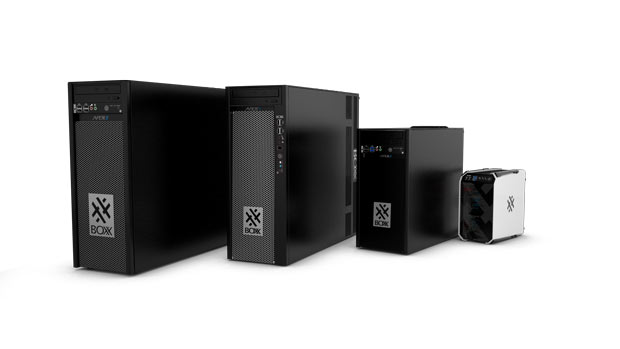A Crash Course in Workstation Configuration

The entire APEXX portfolio. Image courtesy of BOXX Technologies
Latest News
December 1, 2015
 Configuring the ideal workstation for your specific workflow can be a daunting task. With that in mind, BOXX Technologies has assembled a mini buyer’s guide designed to help engineers sort through processor, GPU and hard drive configurations, and make a custom workstation match.
Configuring the ideal workstation for your specific workflow can be a daunting task. With that in mind, BOXX Technologies has assembled a mini buyer’s guide designed to help engineers sort through processor, GPU and hard drive configurations, and make a custom workstation match.
Processor Cores and Threads vs. Frequency
Aside from budget constraints, the most significant consideration is CPU cores — specifically, how fast and how many. Modern workstations range from four to up to 18 cores, and many include hyper threading, which theoretically doubles the system’s ability to process threads (but does not double its performance).
Frequency-bound applications, including 3D modeling tools like SOLIDWORKS or Autodesk 3ds Max, benefit from CPU frequency more than cores. That’s why BOXX offers safe overclocking, which provides up to 25% more performance by unlocking the built-in frequency headroom found inside Intel CPUs. Our maximum frequency workstation is APEXX 2 Model 2401.
Highly threaded applications, such as rendering or simulation, can benefit from multiple cores, thus we recommend Intel Xeon processors with high thread counts such as the APEXX 4 Model 7901. If a workflow requires both higher frequencies for interactive activities and high thread counts for rendering or simulation, the optimal solution would be to combine an APEXX 1 Model 1401 with a BOXX renderPRO 1, a desk-side rendering and simulation solution.
The GPU
The graphics processing unit (GPU) is primarily responsible for what you see on your screen. GPUs come in a variety of flavors from NVIDIA and AMD. 3D design and modeling applications rely on the GPU to keep frame rates up for smooth panning, zooming and rotating when creating and manipulating 3D objects. However, these applications are frequency bound and can’t take advantage of multiple GPUs. For good viewport performance in these applications, we recommend a minimum configuration of an NVIDIA Quadro K1200 GPU
For certain rendering and simulation applications, the GPU can work in the background, operating exponentially faster than a CPU. Examples include GPU rendering engines like V-Ray RT, Iray or Octane, and simulation applications such as CATIA or ANSYS. In most of these cases, higher end GPUs will result in linear performance gains.
Hard Drives
The unsung hero in system responsiveness is a workstation’s storage technology. While the basic functionality of mechanical hard drives hasn’t changed in over a half century, the technology used to increase performance and storage size has evolved, all while delivering smaller and more innovative form factors. Despite such advancements as migration from Parallel ATA (PATA) to Serial ATA (SATA) and new technologies like Native Command Queueing, onboard caching, faster on-board processing, denser platters and increased spindle speeds, the mechanical hard drive still has inherent limitations that can be detrimental to your workflow.
It’s safe to assume that all solid-state drive products (especially the Intel 750 SSD) will outperform mechanical drives in booting up a system, opening programs and any other bandwidth-intensive applications. Mechanical drives are only recommended for storing and archiving data and not for active projects.
RAM
Open up your task manager and look at your RAM usage while working. If during your most intensive tasks, you’re not coming within 30% of the maximum RAM amount, you’re probably in a safe range. However, more RAM means more room for multitasking, so investing in additional memory can be beneficial to your overall workflow. The minimum recommendation is for 16GB of RAM, while large data sets for simulation, large scenes with lots of polygons and textures, and complex parts in engineering applications will benefit from additional memory.
Subscribe to our FREE magazine, FREE email newsletters or both!
Latest News
About the Author
DE’s editors contribute news and new product announcements to Digital Engineering.
Press releases may be sent to them via [email protected].







